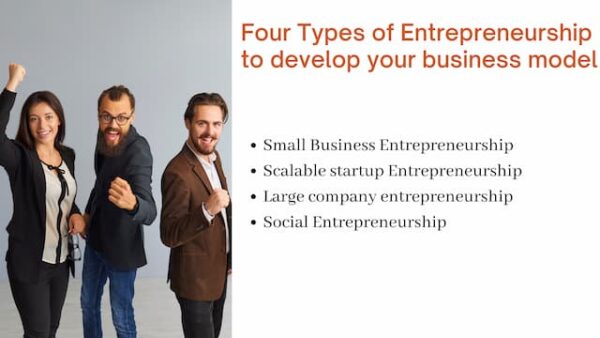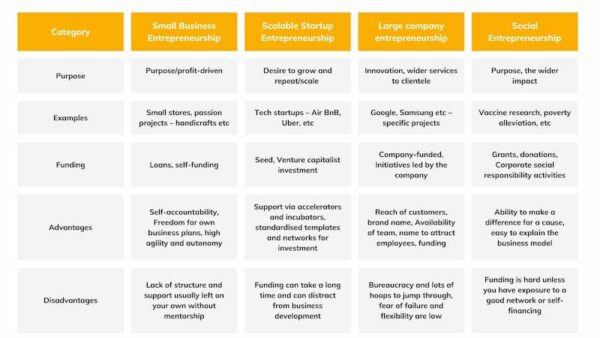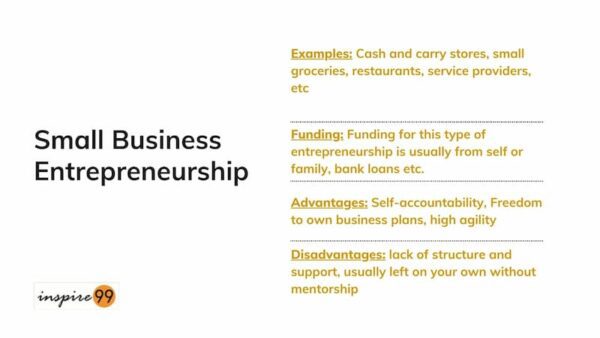What are the four types of entrepreneurship? As a founder, your type of entrepreneurship defines your funding, resource planning and profit models to develop a business plan. I’m aiming this article as a foundation for you as a founder to define the type of business you want to develop.
The four popular types of entrepreneurship are:

You will find some other types of entrepreneurship such as solopreneur, hustler, imitator, researcher, etc. However, I’ll reserve my details on the above four types of entrepreneurship in this article.
Differences between the four types of entrepreneurship
Before detailing the individual types of entrepreneurship, I wanted to provide a summary of the difference between the four types of entrepreneurship. This table is a snapshot of the 4 blocks of entrepreneurs and their categorical focus. We will be debating in detail, each type of entrepreneurship to give you a focused view of each. The differences between types of entrepreneurship are categorised into purpose, advantages and disadvantages of each type of entrepreneurship. We will also go into some examples of types of entrepreneurship in this representation. You’ll also notice that one of the main areas of difference is in the type of funding for the startup. Depending on the investment, you can extend it to the type of business exit or scaling processes.

As an entrepreneur, you must ask yourself this question about the type of entrepreneurship you want to be associated with. Depending on this category of entrepreneurship, you can identify your sources and network to help your growth. For instance, social entrepreneurship will get more grants compared to a profit-oriented business. However, a scalable startup usually has a larger pool of investors and mentors to help grow your business. Ultimately, the type of entrepreneurship comes down to the purpose and value of your business idea.
Types of entrepreneurship and differences
This tables shows the detail of types of entrepreneurship in a copyable format.
| Category | Small Business Entrepreneurship | Scalable Startup Entrepreneurship | Large company entrepreneurship | Social Entrepreneurship |
| Purpose | Purpose/profit-driven | Desire to grow and repeat/scale | Innovation, wider services to clientele | Purpose, the wider impact |
| Examples | Small stores, passion projects – handicrafts etc | Tech startups – Air BnB, Uber, etc | Google, Samsung etc – specific projects | Vaccine research, poverty alleviation, etc |
| Funding | Loans, self-funding | Seed, Venture capitalist investment | Company-funded, Initiatives led by the company | Grants, donations, Corporate social responsibility activities |
| Advantages | Self-accountability, Freedom for own business plans, high agility and autonomy | Support via accelerators and incubators, standardised templates and networks for investment | Reach of customers, brand name, Availability of team, name to attract employees, funding | Ability to make a difference for a cause, easy to explain the business model |
| Disadvantages | Lack of structure and support usually left on your own without mentorship | Funding can take a long time and can distract from business development | Bureaucracy and lots of hoops to jump through, fear of failure and flexibility are low | Funding is hard unless you have exposure to a good network or self-financing |
Small Business Entrepreneurship
The majority of new businesses fall under small business entrepreneurship. This category of business encompasses small ventures. The size of funding doesn’t necessarily classify this type of entrepreneurship. The purpose of such businesses ranges from providing excellent quality of service or profit-making.

Examples: Common examples of small business entrepreneurship are cash and carry stores, small groceries, restaurants, service providers, etc. Normally I would also classify franchisee businesses such as Mc Donalds or KFC under small business entrepreneurship from the perspective of a founder who is setting up this chain. Individual influencer-based entrepreneurship such as Instagram influencers, product testers etc also come under this category
Funding: Funding for this type of entrepreneurship is usually from self or family, bank loans etc. These type of businesses generally don’t undergo venture capitalist or seed funding.
Advantages: Self-accountability, Freedom to own business plans, high agility
Disadvantages: lack of structure and support, usually left on your own without mentorship
Should I be a small business or a startup?
As a founder, I’d strongly advise you to ask this question. A small business gives you loads of flexibility about the type of customers you want to work with without the additional pressure of growing. As a startup, you can’t avoid the pressure to grow since your board, investors and everyone will be asking about it.
A small business however has its own beauty. You can focus on innovation and wield power and authority about the type of businesses you choose to work with. People wrongly associate small businesses with lack of hunger or drive to grow. I find small businesses mature and simply beautiful because they understand their purpose well and fixate on the happiness in the type of value they can offer. You may not get the glowing hockey curve growths that startups get. But small businesses entrepreneurships tend to have higher satisfaction rates and low stress as opposed to a scalable startup entrepreneurship.
Scalable Startup Entrepreneurship
Scalable startup entrepreneurship comprises modern startup ideas intending to grow. The difference between small business entrepreneurship and startup is in its growth plan. The most common pattern of a startup is to create a viable business that can be repeated at scale. Once a product/market fit is identified, aggressive growth is almost imperative for scalable startup entrepreneurship.
Examples: Famous examples of scalable startup entrepreneurship include Uber, Air BnB and similar businesses. With its ease of scaling, technology forms a necessary but not mandatory part of this type of business. The majority of scalable startups focus on international or geographical expansion. The common theme is to start small, succeed and expand with scale.
Funding: Startups are funded either through seed investment or venture capitalist funding. Initial funding is either through self or loans, family etc. However, scaling usually requires a large boost which is provided via investment areas. If you want to create a startup, you will find support via incubators or accelerators to build a business plan to scale.
Advantages: Support via accelerators and incubators, standardised templates and networks for investment
Disadvantages: Funding can take a long time and can distract from business development
Large company entrepreneurship
Large companies because of their size find it difficult to stay on top of the market demand. To cater to customers’ needs, these companies set up dedicated projects for specific innovation ventures. This is similar to the definition of an Intrepreneur which we explored in types of entrepreneurs. In essence, these large companies treat new developments as separate businesses within the large company. You will be working as an entrepreneur as an employee for the company and will need to undergo similar journeys.
Examples: Large companies such as google conduct these ventures. Examples of such entrepreneurial ventures can be separate initiatives such as Google glasses, self-driving cars etc. These projects have a specific outcome, investment and milestones to reach just as any other startup would.
Funding: One of the biggest advantages of large company entrepreneurship is that the company funds your venture. You will also have access to the customer pool. However, you’ll still be under the control of the company and have less freedom as opposed to an entrepreneur in a startup.
Advantages: Reach of customers, brand name, Availability of team, name to attract employees, funding,
Disadvantages: Bureaucracy and lots of hoops to jump through, fear of failure, flexibility is low
Social Entrepreneurship
Social entrepreneurship has a social/environmental cause at heart. This is a special type of entrepreneurship in the sense that it is not a business built for profit. Instead, social entrepreneurship is built to create a wider impact and has a cause to which the entrepreneur strongly relates. It follows a similar business plan approach and resourcing methodologies, but profit models are minimal.
Examples: NGOs, Muhammad Yunus’ micro-financing model, funding for vaccine research, education, poverty alleviation etc. Most of this social entrepreneurship is started with a strong social cause
Funding: Donations, charity and corporate social ventures supported by large companies. In addition, social entrepreneurship is also supported via grants and corporate social responsibility activities.
Advantages: Ability to make a difference for a cause, easy to explain the business model
Disadvantages: Funding is hard unless you have exposure to a good network or self-financing
Other Types of Entrepreneurship
In addition to the detailed list, there are a few others which are gaining popularity. In this section, I’d like to provide a brief definition of these other types of entrepreneurship.
Innovative Entrepreneurship
Innovative entrepreneurship refers to entrepreneurs who are trying to invent or discover the next big differentiator. These are typically led by patents, new innovations. Most of these businesses tend to fall under the category of using technology as an enabler. The most beautiful aspect of innovative entrepreneurship is that it elevates the competition and forces them to think of different ways of satisfying customer needs.
Buyer entrepreneurship
Buyer entrepreneurship sounds a lot simpler. As the name indicates, it is about purchasing new businesses with the intent of developing them further. Sometimes, these purchases are a way to widen your portfolio of services. It is similar to a holding company. But the main difference is that the buyer entrepreneur will take an active part in the business.
Imitator Entrepreneurship
I believe that the roots of imitator entrepreneurship are in cost and price-based business. This is typically an entrepreneur who takes a successful product or service and replicates it. They usually have subtle differences in innovation, customer service etc. But the biggest difference is often their price and cost model where they tend to innovate.
Researcher Entrepreneurship
Researcher entrepreneurs focus on data, and analytics to define a hypothesis. This hypothesis is further backed by loads of user research for either an upcoming area of innovation. It usually relies on social data, models and a theoretical grounding of why something should succeed. This research is usually accompanied with academic papers and publications.

Pingback: The 5 basic Choices in an early stage Startup - Inspire99
Pingback: Principles for Building mindful startups as a Founder - Inspire99
Pingback: How To Build Your Brand As a Nonprofit - Inspire99
Pingback: 5 strategic steps for your startup branding - Inspire99
Pingback: 5 Stages of Startup from idea to Exit for an Entrepreneur - Inspire99
Pingback: The word Entrepreneur is derived from Entreprende - Meaning - Inspire99